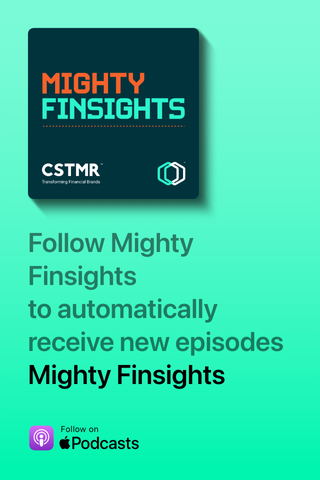AI is rapidly changing how we think about SEO and digital visibility. While the strategies covered in this article remain essential, they now operate within a broader framework we call Discovery Optimization—an approach that unites SEO, AEO (Answer Engine Optimization), and GEO (Generative Engine Optimization) to help financial brands build authority and trust across every discovery channel. Learn more about how the full framework in our Discovery Optimization guide.
Do you know what your customers want? Do you know what they really, really want?
They’re telling you what they want all the time, but learning the answer isn’t as easy as listening to a Spice Girls song.
We marketers, like romantic partners, must act like detectives, studying what our customers say and don’t say. Because we are helping sell products or services, we often get lost in features, pricing, keywords, and other obvious signals. We miss the deeper message: the desires that hide below the search terms and survey responses. We miss the intent.
Harvard Business School professor Theodore Levitt once said, “People don’t want to buy a quarter-inch drill. They want a quarter-inch hole!”
Unfortunately, in the world of modern digital marketing, very few customers actually type and search for “quarter-inch hole” in their favorite search engine. There’s a gap between what they say or search for, and what they really want.
That’s why the topic of search intent is so important.
By studying search intent, marketers in fintech and financial services can uncover valuable details about how to reach customers on their (search) terms.
In this article, we will cover how to use keyword search intent as one of the foundational pillars for your digital marketing strategy.
What Is Search Intent?
Let’s begin with a simple example.
If you search for “new york city housing prices” you’ll find some accurate information about housing prices and trends. But if I’m a real estate agent in New York, studying relevant search terms and traffic, that search query still leaves me in the dark.
I don’t know if you, as one of 50 searchers, are a buyer, a seller, or even an agent. I can see you belong to a group of searchers with an explicit behavior (i.e., you searched for the term), but I don’t know your implicit goal.
That’s the difference between search terms and search intent. Search engines such as Google, Bing, DuckDuckGo, and others are constantly looking for ways to help their users achieve implicit goals, not just deliver keyword-relevant webpages.
When businesses leverage strategies such as Search Engine Optimization (SEO) and pay-per-click advertising to gain search visibility with their target market, they are trying to close that gap even more.
There are four broad search intent types that I’m about to cover in detail, but for starters, it’s enough to say that some of the most effective brand and performance marketing strategies rely on search intent, not just keywords.
And even though I’m saying “search intent,” which sounds singular, it’s highly variable. Each person in your audience conducts multiple searches a day with a different intent each time.
In essence, search intent should be the foundation of most of your content marketing and paid advertising efforts.
Why Understanding Search Intent Is Important
Once you begin studying the search intent of your target audience, a world of possibilities opens up to you. You’ll have a much stronger sense of what blog articles to write, what videos to make, and how to optimize your paid advertising efforts.
If you help people achieve the progress they’re trying to make (remember, they want “holes, not drills”), then sales of your product or service will rise.
What’s more: after you gain a full understanding of search intent, you may discover ways to improve your product or service to meet those needs. Search intent doesn’t just help you sell; it can drive the development of your offering.
Incorporating search intent into your marketing strategy can help your brand in four important areas:
- Improve user experience: If your content and ads connect to a searcher’s intent, you’ll see higher engagement, lower bounce rates, and higher satisfaction from users.
- Higher search rankings: Search engines tune their algorithms for search intent. The closer your content matches search intent, the higher your pages will rank.
- Better conversion rates: When you understand search intent, you also have a better idea of when and how to convert searchers into buyers. Financial service companies have a lot to gain here, as you have to build trust before you can ask for the sale.
- Competitive advantage: Keywords are obvious, intent is not. Many companies don’t dig past the keywords. If you study search intent, you’ll attract more prospects and convert more of them into buyers.
Additionally, here are three ways that studying search intent can help you improve your marketing tactics:
- Picking the best keywords: You can select keywords that offer a balance of high search volume and the best match to your target audience. You can also avoid wasting time and money on generic keywords.
- Creating better content: As you structure your content around the different types of intent within the buyer’s journey, you’ll see higher engagement and conversion.
- Running better search campaigns: When your strategy is grounded in your audience’s search intent, it becomes much easier to optimize your campaigns, funnels, and bidding approach. The more dialed in you get, the more bang you get for your buck.
Your goal is to study the search intent for keywords relevant to your industry/offering/target audience, document the most important types for your business, and continually evaluate how you address that intent in your marketing.
The Evolution of Search Intent in Search Engines
In the early days of search engines (anybody remember Yahoo, Excite, or AskJeeves.com?), the technology focused on matching keywords without considering much of the context. This led to nefarious marketing practices such as keyword stuffing, as people tried to game the system for page views.
Since then, Google has become the dominant search engine.
Google has also prioritized the notion of search intent as they have evolved. They’re constantly trying to learn how to suss out search intent, because it not only helps them sell more ads and other income-generating products, but it also serves up more value to their users.
Here are some driving factors behind Google’s strategy:
- Enhanced UX: Google wants to remove friction from the search process and help users satisfy their needs as quickly as possible. The more that people like the process of using Google and the results it generates, the more frequently they’ll return for future searches.
- Combatting manipulative SEO: If the internet is a game, then some people are always going to cheat. Keyword stuffing and other black-hat techniques abused Google’s algorithm to improve rankings regardless of relevance to intent. Google is perpetually seeking ways to penalize black-hat behaviors and reward relevance.
- Advancements in AI: Google has been a pioneer in the use of artificial intelligence and machine learning to improve search results. Natural language processing (NLP) and large language models (LLMs) both contribute to the way Google interprets search intent.
- Diverse search methods: Users now conduct searches using voice, on mobile devices, and through conversational interfaces. Each of these methods adds layers of context to aid Google in discerning search intent. They also present unique challenges to overcome.
Google has been refining its search engine algorithm for more than 20 years, leveraging a number of different ranking systems during that time. It’s fascinating to see how it’s evolved, and well worth it to review some of the major inflection points throughout its history:
- Florida Update (2003): This was the first shot across the bow for practitioners of black-hat SEO. Google’s algorithm punished spammy SEO tactics and caused many websites to lose their rankings (deservedly so) right before the holiday season.
- Hummingbird Update (2013): Although Google released incremental updates prior to this, the Hummingbird update affected 90% of searches worldwide. It was designed to accommodate the increase in conversational inputs such as voice search.
- RankBrain (2015): This marked the introduction of a machine/deep learning algorithm that could better filter search results. It represented a major improvement in Google’s understanding of how search terms relate to abstract concepts.
- Passage Ranking (2016): Originally released in 2016, it received a major update in 2021. This update allowed Google’s algorithm to rank entire passages of text from a website for relevance to a search query.
- BERT (Bidirectional Encoder Representations from Transformers) (2019): BERT used neural networks to conduct NLP and better understand the context of a conversational search query. It rolled out in more than 70 languages worldwide.
- AI Overviews (2024): Google rolled out AI-generated summaries to search queries for U.S. traffic. This system uses Google’s Gemini model to generate text responses and provide links to relevant sites used in the summary.
All this said, you don’t need to understand each historic update to craft a search strategy in 2025. In practical terms, the most recent changes are the most important for our purposes.
The Shift Toward Semantic Search and User Experience
In the countless updates Google has made to its ranking systems and algorithms over the years, it has aimed to better understand the meaning behind search queries, not just the content.
This includes semantic nuances, or how the meaning of a word changes based on the words that appear prior to and after it.
Google has also implemented changes that improve rankings based on the user experience of a page, including page loading speed, mobile-friendliness, and content relevance. They also introduced featured snippets and rich results to help satisfy users’ questions without requiring them to leave the search results page.
How Google’s Changes Affect Fintech and Financial Services
Back in 2013, Google released the Payday Loan Update, which was designed to correct search results around specific industries such as payday loans, high-interest loans, debt consolidation, casinos, mortgages, and insurance (along with a few other industries).
The goal was to reduce spammy behavior around these industries, not to punish legitimate businesses.
The change highlights the importance of what some call EAT–expertise, authoritativeness, and trustworthiness. Many searches related to financial services involve detailed and sensitive questions tied to personal finance, and brands that demonstrate the EAT attributes will rank higher than companies that are trying to game the system.
As Google improves its understanding of search intent and context, its algorithms are better able to identify relevant content and even filter results by geography and other personal preferences.
Companies and financial institutions that deliver EAT on a consistent basis will find their SEO and digital marketing efforts perform much better.
Types of Search Intent
I mentioned earlier that there are distinct search intent types. These categories help clarify the ways that users approach internet searches, what they’re looking for, and how they can best be helped.
Understanding what these four categories look like for your audience is vital to your marketing success. When you fail to comprehend and meet users in their intent, you waste time and money.
1. Informational Intent
When a user is gathering information that isn’t obviously related to a purchase decision, we call that informational intent.
Users typically use terms such as “what,” “how,” “why,” and “best way to.” Informational intent usually maps to the earliest part of a buyer’s journey.
Here are some examples of search queries with informational intent:
- “What is a cryptocurrency wallet?”
- “How do peer-to-peer loans work?”
- “Benefits of using mobile banking apps”
- “Latest trends in fintech innovation”
At CSTMR, we recommend that our clients dedicate a significant percentage of their content efforts to addressing informational queries, as it goes a long way in building trust and authority. These efforts should include educational blog posts, guides, and whitepapers, as well as frequently asked questions (FAQs) and multimedia educational content such as explainer videos.
Your goal is to break complex topics into digestible, jargon-free pieces of content that educate and deliver real value in exchange for… nothing. This helps establish your credibility on the subject and builds trust by giving value away for free.
2. Navigational Intent
Navigational intent describes a situation where a user is trying to find a specific page, and they’re already clear on the brand or product in question.
Here are some examples of navigational search queries:
- “PayPal login”
- “Robinhood app download”
- “Visa credit card customer service”
- “Stripe API documentation”
- “Wells Fargo routing number”
Similar to informational searches, a user with navigational intent isn’t trying to buy something.
As such, you don’t want to waste time or money pushing for conversions. Instead, you want to make sure your website is easy to navigate and your pages rank for branded keywords. Use clear branding in meta titles and page descriptions, as well as enhance visibility with site links and structured data.
The benefit of optimizing for navigational intent is to help users accomplish their desired tasks quickly and easily. It also helps limit your competitor’s ability to intercept traffic.
3. Transactional Intent
Companies wish that everybody were running Google searches with transactional intent. These searchers want to buy or complete a specific action, like an application for a loan.
These are some examples of transactional searches in the fintech and financial services space:
- “Open a high-yield savings account online”
- “Apply for a business loan”
- “Buy X with credit card”
- “Sign up for X investing app”
Transactional search queries are the ones that see the most competition for keywords and clicks.
You want to capture these searchers with optimized web copy/landing pages, clear calls-to-action (CTAs), and smooth sales funnels. Make your conversion process as easy as possible, and seek to enhance trust with security certifications and social proof.
We consult with many of our clients on how to develop a seamless buying experience for their hot leads (searchers with transactional intent). Do it well, and your conversion rates and revenue will jump.
4. Commercial Investigation Intent
A lot of content on the internet is created expressly for this type of intent. Product comparisons, reviews, “This vs. That” blog articles, and “best X/product for X/task” articles are aimed at helping users who are comparing options before purchasing.
The Wirecutter is an example of a brand built entirely on feeding demand for commercial investigation searches.
In financial services, these searches can look like:
- “Best online brokers for beginners”
- “SoFi vs. LendingClub loans”
- “Top mobile payment apps”
- “Reviews of the Chase Sapphire credit card”
Your best bet for capturing these users is to publish comparison articles, product reviews, and buyer’s guides, along with free trials (whenever possible).
Commercial investigation searches are basically a hybrid of informational intent and transactional intent.
They’re not ready to buy yet, but they’re open to being convinced. This is a powerful moment to influence purchase decisions and address potential objections. If you don’t use these opportunities to connect with users, your competitors will.
Determining Search Intent
While Google’s algorithm does a lot of work to assess search intent, you’re the only one who can do the hard work of creating a specific location for Google to send searchers.
Here are some of the things I review with our clients when we sit down to optimize their SEO strategy.
Keywords and Query Context
Resist the urge to take keywords at face value. You must explore the context and nuances that are driving the search query.
Here are some patterns we’ve noticed in the financial services space:
- Informational intent: Queries often start with “how,” “what,” or “why,” such as “how does compound interest work.”
- Commercial investigation intent: Searches might include “best,” “top,” or “reviews,” like “best online mortgage lenders.”
- Transactional intent: Phrases include action words like “apply,” “buy,” or “open,” such as “apply for a personal loan online.”
Whenever possible, you want to map the buyer journey clearly so that you can see how users move between phases of intent and the behaviors they exhibit along the way.
SERP Features and Results
Conduct your own searches. Find out what Google returns on the search engine results pages (SERPs) for your target keywords. This will give you excellent clues about what other companies (and Google) think is happening with similar searchers.
For example, if you search “neobank explained” and the SERP shows you educational content, then it’s a fairly safe bet that the audience has informational intent.
Alternatively, a query like “best savings account” is probably someone with commercial investigation or transactional intent. They’re ready to open a savings account and want to find the best rate. This should be reflected in the SERPs.
You can find additional clues for search intent with Google’s SERP features, which include the likes of featured snippets and knowledge panels.
These sections can reveal a lot about the audience and their state of mind when searching. You can’t control what’s shown, but it can help guide your keyword and content strategies.
Keyword Research Tools and Analytics
There are some excellent keyword tools to aid your research. You can explore search volume, keyword difficulty, and related search terms. Armed with this data, you’ll be positioned to select exactly which keywords are worth targeting and which ones aren’t.
Let’s say you’re trying to promote a credit card.
So, you plug “credit card rewards” into the keyword tool. It shows you that searchers with informational intent searched for “how do credit card rewards work,” while searchers with commercial investigation intent searched “best credit card rewards.” Your next step is to plan out different pages or content pieces that fulfill the intent of these searches.
Use Google Analytics (GA) and Google Search Console (GSC) to connect the dots between your keyword research and the behaviors of people who visit your site. These tools can show you which search queries bring visitors to your site, how long they stay, and what pages they visit.
Ideally, you’ll want to leverage metrics like engagement rate, bounce, conversion rate, top pages, top queries, etc., to show you where your site is working well and where it is struggling.
As you assemble the different pieces of the puzzle, you’ll start seeing opportunities to optimize your website and campaigns. Don’t let yourself get overwhelmed; SEO is a marathon, not a sprint.
The Impact of GenAI and AI Search on Search Intent
As I mentioned in the overview of Google’s search engine algorithm, the introduction of AI overviews marks a pivotal moment in SEO and digital marketing. We’re still learning how users engage with this new development and what changes Google will make in the near future.
Here are a few of my observations:
AI Providing Direct Answers: Fewer Clicks to Websites
Generative AI models powered by LLMs are increasingly able to answer informational searches without the user visiting additional websites or clicking on other content. On the surface, this may reduce organic traffic to informational content and require a rethink of how brands can gain visibility.
Our best recommendation is to lean into developing detailed, authoritative content that AI would struggle to produce accurately. Consider the data or insights that you have proprietary access to. Look for ways to make your content entertaining and engaging; i.e., give people more reasons to click through to your site.
Content Needs to Be More Intent-Focused and Comprehensive
AI models will get better at answering user questions and engaging in long, detailed conversations. User expectations will continue to rise, meaning that mediocre, surface-level content will fail to gain any attention.
Brands need high standards for their content, and they need to strategically develop pieces that drill deep.
Look for ways to resonate with your audience at the different stages of awareness and intent. An AI overview might describe your brand or product accurately, but it won’t create a connection with your audience and give them reasons to choose you.
Optimize for Conversational Search and Long-Tail Queries
It looks like AI search dynamics may lean toward long, complex queries, de-emphasizing short, high-volume keywords. Your content needs to address long-tail keywords and comprehensive answers to conversational queries.
ROI of UX and Multimedia Content Will Increase
Even if users rely on AI to feed them more information, they are still hungry to engage with brands they like. Consider producing multimedia content such as videos, podcasts, and interactive digital experiences that go beyond what AI can do.
Take the time to study your audience and learn about their needs and desires. If you’re able to connect with them at an emotional level, you can differentiate from AI-driven SERP.
User Intent Across the Funnel Will Shift
With AI handling more and more informational queries, users are likely to arrive at your site with commercial investigation or transactional intent instead. They’re farther along the buyer’s journey, which can be a great thing—if you’re ready.
Measuring Search Intent Success
How will you know if your SEO efforts are working? Measure it!
No, but really, you will want to measure how well your website and sales were doing before and after any changes or shifts in strategy.
Some types of digital attribution are getting much harder—but that doesn’t mean you should stop tracking them. It does mean you have to get more determined and creative.
- Click-through rate (CTR): The more relevant your content is to a user’s search intent, the higher your CTR. There are other factors that can interfere with CTR, so it’s important to look at your funnel holistically and optimize.
- Bounce rate: A “bounce” happens when somebody visits your site and leaves quickly. That’s a good clue that users experience a disconnect between their search intent and the content that you ranked for in Google. High or abnormal bounce rates are red flags you should address quickly.
- Engagement rate: Engagement shows the percentage of sessions where users interacted with your content in a meaningful way (e.g., clicking links, filling out forms, or watching videos). Poor engagement means there are issues with your content.
- Average engagement time: This shows you how long people are spending on your site. Run a quick test to see how long it takes to read a blog article or watch a video on your site. Then, compare it to the average engagement time. You’ll get an idea if people are sticking around or jumping to the next thing because your content isn’t a good fit.
- Conversion rate: This can be a purchase or another important action you designate, such as an email signup or application. If you have high traffic to a page and a low conversion rate, it’s a strong signal that you need a better match between the search intent and the content or UX of your site.
- SERP position and ranking stability: Keep an eye on this. If your rankings dip significantly, it could be a sign that Google has made a change or that a competitor is edging you out of the SERP.
There’s a lot to look at. And while none of the metrics is inherently more important than others, the more you track and monitor, the better you can adjust and pivot when needed.
Adjusting and Optimizing Content
Once you start the journey of looking at how well user search intent and your site work together (or don’t), it can feel like everything is broken. Don’t worry, that’s normal.
For some businesses, a website/content strategy overhaul is in order, but when you overhaul a site, you lose all the comparative measurements that let you know which changes mattered. You have to rely on raw numbers like sales or overall traffic to see what’s working.
Incremental changes can allow you to learn far more about your audience and how to serve them better. Here’s what we recommend you consider first:
- Conduct regular content and website audits: Before you change anything, you need to know which pages and articles are working well and which ones are struggling. Once you have a list and break it up by performance, you can plan changes.
- Optimize low-performing pages/content assets: Start with the worst-performing pages/content assets. Are there quick remedies that your team can implement? Updated info, new visuals, and clearer CTAs are all simple ways to boost a page’s performance.
- Improve high-ranking pages/content assets: Look at the pages/content assets that rank highly. Can you update the meta titles and descriptions to better align with search intent?
- Increase conversion rates: For pages/content assets that serve transactional searches, you need to dive deep into the user experience. Where is there unnecessary friction that stops people from completing the desired action? Can you remove it?
- A/B test different approaches: The best way to test your changes is to run comparative, or “A/B,” tests on multiple versions. A/B testing helps you discover the most compelling headlines and the most effective sales pages.
- Expand successful content: Look at your top-performing articles, videos, podcasts, or other content. Find ways to expand those ideas into other channels or formats.
Consider making changes in phases.
Your first phase should be focused on fixing obvious problems as quickly as possible. After you’ve put out the fires, you can start optimizing and planning around specific goals, such as user growth, application volume, or consultations.
Make It Last Forever, SEO Never Ends
Despite dire warnings about AI and how it will kill SEO, the future is uncertain.
Every time Google has changed its algorithm, some businesses have struggled, while others have grown. Few people like change that is outside their control.
Here’s what isn’t going to change: people will always have the desire to gain new knowledge, compare products, and buy new things. Search intent is the force driving search engine development and optimization.
Your business goal should be to find ways to meet users in their search activity and help them achieve their desired tasks or actions. Thankfully, there are fundamental principles of brand and performance marketing that can help you do that without raising a white-flag to the machines.
If you wannabe a top-ranking item on Google’s SERP, CSTMR can help you discover what your customers really, really want and how to help them get it.




